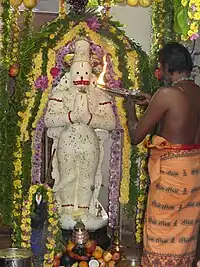Hanuman Jayanti
Hanuman Jayanti (Sanskrit: हनुमज्जयंती, romanized: Hanumajjayantī) is a Hindu festival celebrating the birth of the Hindu deity, and one of the protagonists of the Ramayana, Hanuman. The celebration of Hanuman Jayanti varies by time and tradition in each state of India. In most northern states of India, the festival is observed on the full-moon day of the Hindu month of Chaitra (Chaitra Purnima).[5][6] In Karnataka, Hanuman Jayanti is observed on Shukla Paksha Trayodashi, during the Margashirsha month or in Vaishakha, while in a few states like Kerala and Tamil Nadu, it is celebrated during the month of Dhanu (called Margali in Tamil). Hanuman Jayanti is observed on Pana Sankranti in the eastern state of Odisha, which coincides with the Odia New Year.[7]
| Hanuman Jayanti | |
|---|---|
 Hanuman worshipped on Hanuman Jayanti | |
| Observed by | Hindus |
| Type | Religious |
| Observances | visiting temples, offerings, reading of Hanuman Chalisa and Ramayana |
| 2023 date | Most regions 06 April (Eastern Hemisphere)[1] 05 April (Western Hemisphere)[2] Telugu date 14 May[3] Kannada date 24 December Tamil and Malayali date 11 January 2024 (Eastern Hemisphere) 10 January 2024 (Western Hemisphere)[4] |
| Frequency | Annual |
| Part of a series on |
| Hinduism |
|---|
 |
Hanuman is regarded to be an ardent devotee of Rama, an avatar of Vishnu, widely known for his unflinching devotion.[8] He is revered as a symbol of strength.[9]
Birth

Hanuman is a vanara, born to Kesari and Anjana. Hanuman is also known as the celestial son of Vayu, the wind-god.[10][11] His mother, Anjana, was an apsara who was born on earth due to a curse. She was redeemed from this curse upon giving birth to a son. The Valmiki Ramayana states that his father, Kesari, was the son of Brihaspati, the king of a region named Sumeru, located near the kingdom of Kishkindha near Hampi in present-day Vijayanagara district of Karnataka.[12][13] Anjana is said to have performed intense prayers lasting twelve years to Shiva to bear a child. Pleased with their devotion, Shiva granted them the son they sought.[14]
Eknath's Bhavartha Ramayana states that when Anjana was worshiping Rudra, King Dasharatha of Ayodhya was also performing the ritual of Putrakameshti under the guidance of Sage R̥śyaśr̥ṅga in order to have children. As a result, he received some payasam (Indian pudding) to be shared by his three wives, leading to the births of Rama, Lakshmana, Bharata, and Shatrughna. By divine ordinance, a kite (bird) snatched a fragment of that pudding and dropped it while flying over the forest where Anjana was engaged in worship. Vayu, delivered the falling pudding to the outstretched hands of Anjana, who consumed it. Hanuman was born to her as a result.[13][15]
Worship
Hanuman is worshipped as a deity with the ability to gain victory over evil and provide protection. On this festival, devotees of Hanuman celebrate him and seek his protection and blessings. They join in temples to worship him and present religious offerings. In return, the devotees receive prasadam.[6] People who revere him read from Hindu texts like the Hanuman Chalisa and Ramayana.[11] Devotees visit temples and apply a vermillion to their foreheads from Hanuman's murti. According to legend, when Hanuman found Sita applying sinduram to her forehead, he enquired about this custom. She replied that doing so would ensure a long life for her husband, Rama. Hanuman then proceeded to smear his entire body with vermillion, thus ensuring Rama's immortality.[16]
Southern India

In Tamil Nadu and Kerala, Hanuman Jayanti is celebrated on the new moon day in Margali (Dhanu) month. Famous Hanuman temples in these states like Nanganallur, Namakkal, Suchindram, Thrikkaviyoor and Alathiyoor celebrate this day with pomp.
In Telangana and Andhra Pradesh, Hanuman Jayanti is celebrated for 41 days, beginning on Chaitra Purnima, and concluding on the tenth day during Krishna Paksha in Vaishaka.[17]
Maharashtra
In Maharashtra, Hanuman Jayanti is celebrated on the full moon day (pūrnima) of the Hindu lunar month of Chaitra. A special feature of Hanuman Jayanti is that according to some religious almanacs (panchāngs) the birthday of Hanuman falls on the fourteenth day (chaturdashi) in the dark fortnight of the month of Ashvin, while according to others it falls on the full moon day in the bright fortnight of Chaitra. On this day in a Hanuman temple, spiritual discourses begin at dawn since Hanuman is believed to have been born during sunrise. During the time frame of birth, the spiritual discourse are halted and the offering of food (prasadam) is distributed to everyone.[18] Spiritual discourses are organised in most of the Hindu temples of the region on this day.
Odisha
In Odisha, Pana Sankranti (April 13/14/15) is believed to be the birthday of Lord Hanuman. The temples remain crowded and people chant Hanuman Chalisha throughout the day. Reading the Sundarkaand on this day is also said to be a pious exercise. The day also marks the beginning of the New Year in the traditional Odia Solar Calendar.[19] The festival occurs in the solar Odia calendar (the lunisolar Hindu calendar followed in Odisha) on the first day of the traditional solar month of Meṣa.
References
- "Hanuman Jayanti". Archived from the original on 24 November 2022. Retrieved 24 November 2022.
- "Archived copy". Archived from the original on 6 April 2023. Retrieved 5 April 2023.
{{cite web}}: CS1 maint: archived copy as title (link) - "Archived copy". Archived from the original on 5 April 2023. Retrieved 5 April 2023.
{{cite web}}: CS1 maint: archived copy as title (link) - "Archived copy". Archived from the original on 6 April 2023. Retrieved 5 April 2023.
{{cite web}}: CS1 maint: archived copy as title (link) - www.wisdomlib.org (9 June 2018). "HanumaJanmotsav, Hanumajjanmotsav, Hanumat-janmotsav, Hanūmajjanmotsav: 3 definitions". www.wisdomlib.org. Archived from the original on 15 November 2022. Retrieved 15 November 2022.
- Melton, J. Gordon; Baumann, Martin (21 September 2010). Religions of the World: A Comprehensive Encyclopedia of Beliefs and Practices, 2nd Edition [6 volumes]. ABC-CLIO. ISBN 978-1-59884-204-3. Archived from the original on 11 March 2023. Retrieved 26 February 2023.
- Biswas, Ramakanta. "Pana Sankranti, Odia New Year Observed Across Odisha; PM, CM Greet People". Archived from the original on 27 February 2023. Retrieved 5 April 2023.
- Lochtefeld, James G. (2002). The Illustrated Encyclopedia of Hinduism: A-M. Rosen. pp. 271–272. ISBN 978-0-8239-3179-8.
- Verma, Manish (2013). Fasts and Festivals of India. Diamond Pocket Books (P) Ltd. ISBN 978-81-7182-076-4. Archived from the original on 11 March 2023. Retrieved 26 February 2023.
- Cole, Owen; Kanit, V. P. Hermant (25 June 2010). Hinduism - An Introduction. John Murray Press. ISBN 978-1-4441-3100-0. Archived from the original on 11 March 2023. Retrieved 26 February 2023.
- The Illustrated Encyclopedia of Hinduism. pp. 272–273. Archived from the original on 2 February 2023. Retrieved 19 March 2023.
- madur (22 October 2014). "Anjeyanadri Hill, Hampi: Journey to the Monkey Temple". Karnataka.com. Archived from the original on 26 March 2023. Retrieved 5 April 2023.
- Encyclopaedic Dictionary of Puranas: (A-C) ; 2.(D-H) ; 3.(I-L) ; 4.(M-R) ; 5.(S-Z) Archived 5 April 2023 at the Wayback Machine, pp=628-631, Swami Parmeshwaranand, Sarup & Sons, 2001, ISBN 81-7625-226-3, ISBN 978-81-7625-226-3
- Sri Ramakrishna Math (1985) "Hanuman Chalisa" p. 5
- Sri Ramakrishna Math (1985) "Hanuman Chalisa" pp. 5-6
- Agarwal, Ruchi (2018). "Hanumān (Hanumant, Hanūman)". Google Scholar.
- "Happy Telugu Hanuman Jayanti 2022: Date, Dasami Tithi, and Significance". The Times of India. 25 May 2022. ISSN 0971-8257. Retrieved 8 April 2023.
- "Hanuman Janmotsav Puja To Make Lord Hanuman Happy". Archived from the original on 1 October 2019. Retrieved 2 October 2019.
- "Festivals of Odisha's Lord Jagannath temple in Puri in 2022-23: Complete list". KalingaTV. 28 January 2022. Archived from the original on 27 February 2023. Retrieved 28 February 2023.
External links
 Media related to Hanuman Jayanti at Wikimedia Commons
Media related to Hanuman Jayanti at Wikimedia Commons
